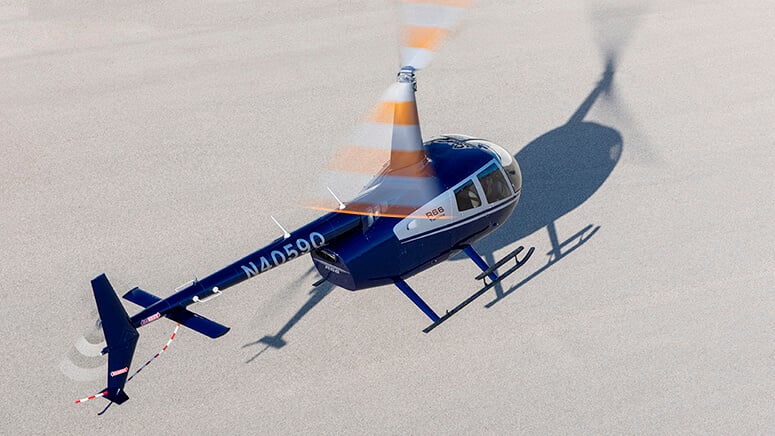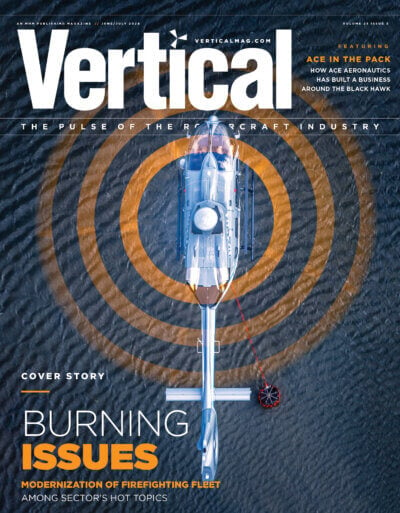
Robinson Helicopter Company has introduced a new empennage for the R66 Turbine helicopter intended to reduce the likelihood of mast bumping, one of the most vexing causes of fatal crashes in the model.
The existing design of the R66, like that of the R44 and R22 before it, features an asymmetrical horizontal stabilizer on the right side of the tail, directly across from the tail rotor. The new empennage, recently certified by the Federal Aviation Administration and officially revealed on Sept. 5, replaces this surface with a fixed, symmetrical horizontal stabilizer located forward of the tail rotor.
Robinson Helicopter President Kurt Robinson said the shift to a symmetrical stabilizer reduces rolling moments, providing enhanced roll stability during high-speed flight. The stabilizer and accompanying new tail cone also have extended times between overhauls (TBOs) of 4,000 hours, compared to 2,000 hours for the existing versions.
The updated empennage will be standard on all new production, FAA-registered R66 helicopters commencing with serial number 1279, which is scheduled for delivery from the factory in the next few weeks. Robinson is also pursuing validation of the design change with other civil airworthiness authorities around the world, and will deliver foreign-registered R66s with the new empennage as regulatory approvals are obtained.
Kurt Robinson told Vertical that the modification is the culmination of extensive data analysis and flight testing and a two-year certification process. “The areas that we’re concentrating on are the edges of the flight envelope . . . to enhance the stability, and what we’ve come up with we believe provides that,” he said.
Mast bumping is a phenomenon that can occur in any helicopter with a two-bladed main rotor system, although it is often associated with Robinson models. In two-bladed rotor systems, when one blade flaps up, the other blade flaps down, much like a seesaw. If the flapping motion is excessive, the root of the down-flapping blade can contact the rotor mast, while the rest of the blade may impact the tail boom or cabin, resulting in the catastrophic break-up of the helicopter in flight.

Mast bumping can be induced through low-G maneuvers, when the weight of the helicopter’s fuselage is momentarily unloaded from the rotor disc. The most common example of such a maneuver is a cyclic pushover — an abrupt nose-over following a climb.
In a safety notice first issued in 1982, Robinson warns pilots against low-G pushovers, explaining that the combination of main rotor torque reaction and tail rotor thrust will produce a powerful right rolling moment on the fuselage. “With no lift from the rotor, there is no lateral control to stop the rapid right roll and mast bumping can occur,” the notice explains, adding that “even highly experienced test pilots have been killed investigating the low-G flight condition.”
In its Helicopter Flying Handbook, the FAA notes that turbulence, especially severe downdrafts, can also cause a low-G condition. Because the risk posed by turbulence is aggravated at higher airspeeds, Robinson limits flight in the R66 to 110 knots — 30 knots below the never-exceed speed — in conditions other than smooth air. In “significant turbulence,” a subjective judgment that Robinson says “will depend on pilot experience and comfort level,” pilots are told to slow to 60 to 70 knots.
Although the new empennage is designed to improve stability at higher airspeeds, Kurt Robinson emphasized that it does not change the authorized flight envelope for the R66. Low-G maneuvers and high-speed flight in significant turbulence remain prohibited, and care must be taken to avoid these conditions.
“It’s still a two-bladed rotor system,” he said. “The last thing we want to see happen is people going out there and trying to experiment with it.” Meanwhile, the company maintains that the previous empennage assembly is safe and effective within the approved flight envelope.
In addition to including the updated empennage on new production helicopters, Robinson plans to make it available as a retrofit kit, potentially early next year, although the exact timing and price for the kit have yet to be determined. Ultimately, the company plans to also certify similar modifications for its smaller, piston-powered helicopters, the four-seat R44 and the two-seat R22.
“We like what we did and we like the results, so we are pushing to get those done, too,” Kurt Robinson said. “We’re going to do it as quickly and efficiently as we can, but I don’t have a timeline for [that] yet.”








